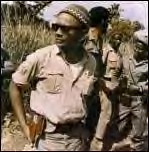
Amilcar Cabral from Cape Verde was the leader of the African Party for the Independence of Guinea-Cape Verde (PIAGC). He was assassinated in 1973 before national liberation in Bissau.
Originally uploaded by Pan-African News Wire File Photos
Vol. 71/No. 42 November 12, 2007
Cuba helped fight for Guinea-Bissau’s independence
(Books of the Month column)
Below is an excerpt from From the Escambray to the Congo: In the Whirlwind of the Cuban Revolution, one of Pathfinder’s Books of the Month in November. The author, Víctor Dreke, has been a leading participant in Cuba’s revolutionary movement for half a century. In 1965 he served as second in command to Ernesto Che Guevara of the Cuban internationalist combatants in the Congo. Dreke is currently Cuba’s ambassador to Equatorial Guinea in west-central Africa. Copyright © 2002 Pathfinder Press. Reprinted by permission.
BY VICTOR DREKE
When we left the Congo, a number of Africans returned to Cuba with us, and one of them came to live in my home. He was like a member of my family. His name was Sumba and here we called him Fidelito. He was killed after returning to the Congo to fight.
Soon after that, in 1966, I left for my first mission to Guinea-Bissau. I headed up our military mission there and in the Republic of Guinea. Keep in mind that Guinea-Bissau was still under Portuguese colonial rule, while the Republic of Guinea had won its independence from France in 1958.
Amilcar Cabral was the central leader of the liberation movement in Guinea-Bissau and Cape Verde, and because of his knowledge of Africa, he made a big impression on me. Che had held a high opinion of the PAIGC (African Party for the Independence of Guinea and Cape Verde). At that time Che considered it a serious and organized revolutionary movement.
I arrived in Guinea-Bissau with the experience I had gained in the Congo and a little more knowledge about Africa.
From a strategic point of view, Amilcar and I didn’t always share the same opinion on how to wage the struggle. But you have to remember that it’s the leaders within each country who must decide the form to carry out the struggle.
I’ll give an example.
One day the liberation movement in Guinea-Bissau decided to recruit a group of young people. They went into a small town and took six young men and brought them to the camp. I didn’t understand this. How can you compel people to join? I said this to Amilcar. “You can’t force people to fight,” I told him. “You must win them over politically.”
Amilcar listened to me very respectfully. Keep in mind he had lots of experience and I was a young person—not yet thirty—and new to that country. “Everything you’re saying is true,” he said to me. “But here that can’t be done. Because tomorrow the Portuguese will come, and they’ll forcibly take them away and conscript them to fight against us. We have to incorporate them into our ranks before the Portuguese do.”
Another question was that of the neighboring Republic of Guinea, with its capital in Conakry. The command of the PAIGC was in Guinea-Conakry. Why? Because there were only two ways to enter Guinea-Bissau: through Senegal—which gave no assistance at all—or Guinea-Conakry, whose government was then headed by [Ahmed] Sékou Touré. Without that rear guard, the armed struggle in Guinea-Bissau would have been wiped out, since food supplies, armaments, and ammunition, which came from Cuba, China, the Soviet Union, and other socialist countries had to go through that country.
This was different from the struggle in our country, where our weapons were captured from the dictatorship’s army. The Portuguese remained in their garrisons and rarely came out to fight. So you couldn’t set ambushes to attack them and seize their weapons. They moved troops, supplies, everything, by plane and helicopter. The liberation movement needed a secure rear guard in order to survive.
That’s why in November 1970, the Portuguese imperialists decided on an operation directly attacking Guinea-Conakry, trying to overthrow Sékou Touré while simultaneously trying to wipe out the liberation movement in Guinea-Bissau. That invasion was defeated by militias trained by Cuban instructors.
The Cuban leadership supported the strategy of strengthening the government of Sékou Touré. He asked for our help. We had to prevent the imperialists from toppling his government. We also knew that the French imperialists still didn’t forgive Sékou Touré or the liberation movement for winning independence a few years earlier.
So Cuba responded to the request by Sékou Touré for Cuban instructors to help create a militia. We also responded to a proposal by Amilcar Cabral to help train artillery personnel and doctors to meet the needs of the people of Guinea-Bissau, sending a small military unit. We taught them the use of artillery and trained them to give medical care to the liberation fighters.
We lived together with these compañeros in the same camps. This brought us even closer to the African struggle, and it enabled us to appreciate and to better understand the African people. And at the same time, they made an effort to understand us.
1 comment:
VIVA FIDEL, VIVA LA REVOLUCION CUBANA!
HASTA LA VICTORIA SIEMPRE
BIEN HECHO DREKE!!
Post a Comment